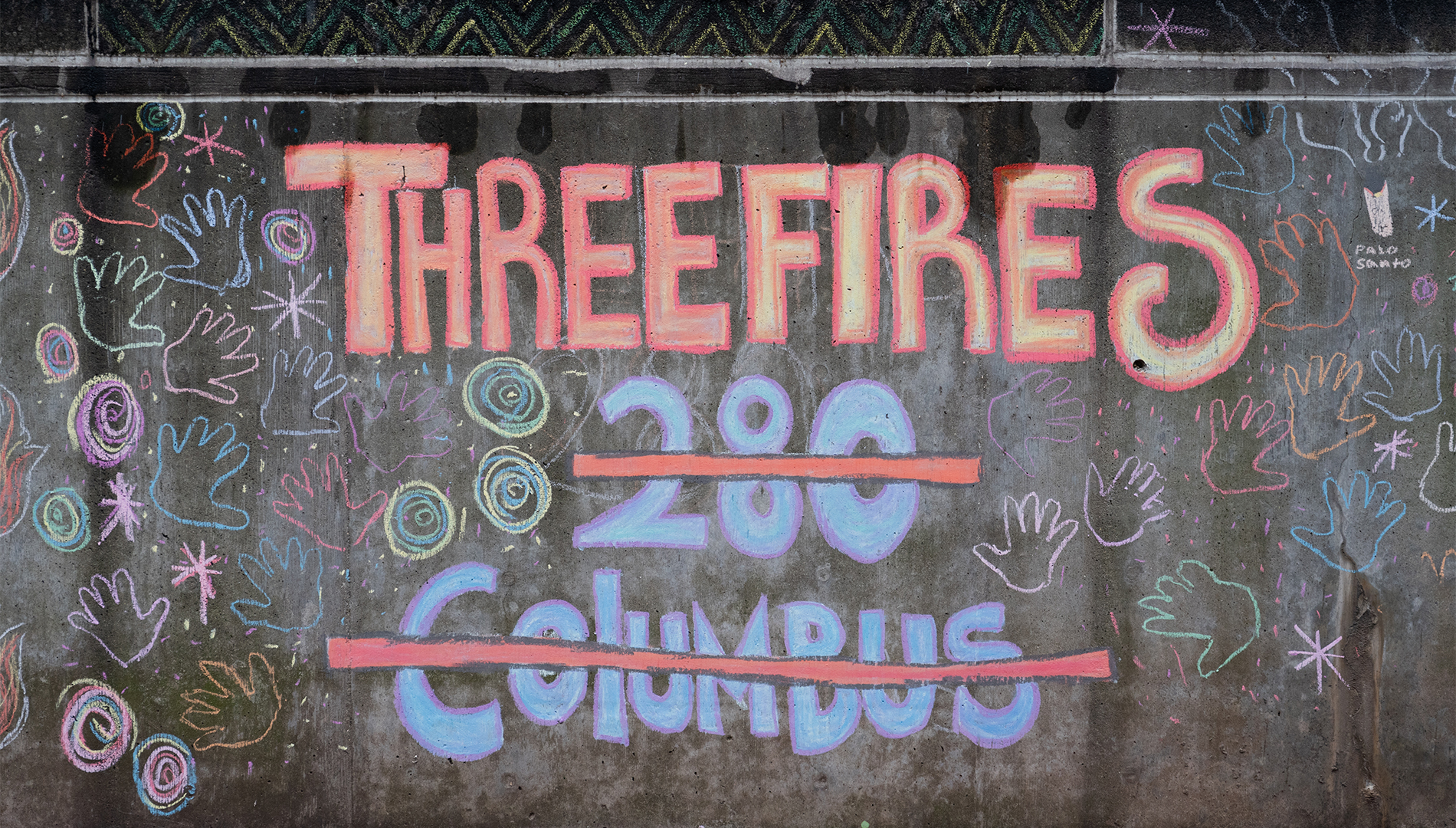The 2020 Black Lives Matter surge of activism and nationwide protests launched upheaval in colleges and institutions across the country. In Chicago, where four out of every five victims of police shootings are Black, the reckonings about racism reached the School of the Art Institute of Chicago (SAIC), which saw its own internal upheaval. Advocacy groups SAIC Solidarity and SAIC Black Futures formed and published letters which left a lasting impact on the campus.
The letters echoed calls on social media for a more decolonized curriculum, a more diverse staff, the renaming of the Columbus Building, improved financial aid for students of color, plus an ombudsperson, and an affinity space for BIPOC students. “We were asking for a school that could imagine itself as truly in solidarity with Black people in Chicago,” said Anna Martine Whitehead, Assistant Professor, Contemporary Practices, and Black Futures member, speaking to F this April.
SAIC’s immediate responses included donations, scholarships, and the establishment of the Anti-Racism Committee (ARC), with numerous subcommittees for items like curriculum, hiring, and the BIPOC space. This spring, almost a year later, the ARC released its first round of action items.
Many who spoke to F agreed that these changes would not be underway without the efforts of SAIC Solidarity and Black Futures. Delinda Collier and Jefferson Pinder, co-chairs of the ARC, told F that they began the first committee meeting by going through the Black Futures letter point by point, along with President Elissa Tenny and Provost Martin Berger. They created subcommittees for each demand they were “able to pursue.” 
The committee, which has numerous subcommittees and over 80 people total, released its first round of recommendations this spring. Some of them match up with the original demands, such as diversifying hiring and SAIC’s curriculum. But other matters, such as labor, mental health, and SAIC’s high tuition — issues that are intimately tied to race and class — remain unaddressed by the committee.
CURRICULUM
ARC recommends a campus-wide diversity course requirement, the specifics of which are not yet determined. Defining a wide-ranging, effective, “anti-racist curriculum” is a long and complex process, Jacob Ristau (Adjunct Associate Professor, VisCom) of the curriculum subcommittee told F. “Bucked up underneath this definition must be metrics,” he said. “What can you hold a ruler against to measure that you did or didn’t do it?”
Thus far, the most concrete action item regarding an anti-racist curriculum is the introduction of a shared text for students to read and discuss in Fall 2021 — “Caste: The Origins of Our Discontents” by Isabel Wilkerson. Meanwhile the diversity curriculum requirement, once settled on, will have to pass through the Senate Curriculum Committee for approval, and may possibly be re-worked multiple times before implementation. According to Collier, ARC co-chair and Interim Graduate Dean, “The ARC is not a top-down, ‘we tell you what to do’ thing,” — it merely makes recommendations.
Curriculum changes on the departmental level have been quicker, and those who spoke to F from Contemporary Practices (CP) and the Art History department were optimistic. Jenny Lee, Assistant Professor, Art History, Theory, and Criticism, was part of her department’s ad-hoc anti-racism committee in spring 2020, and said some of the curriculum changes they recommended are already being put into effect this year. Similarly, CP leadership, which met with SAIC Solidarity over the summer, created a set of readings and viewings for this year’s incoming class. CP also worked with the Chicago Freedom School to host a series of workshops. Whitehead was proud of the speed of the implementation. “We know our students, and we know our faculty.”
DIVERSE HIRING
In its letter, SAIC Solidarity expressed that the mostly-white faculty makes it harder for students of color to see themselves having a future as an artist. As of 2019, according to Department of Education statistics, 75 percent of faculty members at SAIC were white, while 6 percent were Black; the remainder is made up of Latinx, Asian, and Native American faculty members. This is a more diverse faculty than the other prominent AICAD art schools, but still out of proportion with Chicago’s population, which is about 33 percent white, 29 percent Black, 27 percent Hispanic, and 7 percent Asian.
To change this, the ARC’s hiring subcommittee recommends “expanded language” in hiring materials, including a statement of values about diversity.
However, due to this year’s enrollment drop caused by COVID and the recession, SAIC is currently under an indefinite hiring freeze on full-time, tenured, and permanent staff positions.
Part-time faculty are still being hired on a short-term basis as usual, but this poses other diversity problems. In the past, SAIC has hired based on networks — a “who you know” system, as explained by Pinder, ARC co-chair and Director of the Office of Diversity, Equity, and Inclusion. This naturally perpetuates existing racial biases, and does not necessarily expand the SAIC community. One of the ARC’s hiring recommendations is to create a database, so that the part-time hiring process is more systematized, and hopefully less biased.
However, the role of a part-time professor is an inherently insecure position. Even if a given department becomes “more diverse” for the length of that professor’s contract, they are not part of the community in the same permanent way. And those part-time faculty of color should not be responsible for solving all our problems, said Lee: “Bringing on faculty of color does not mean that they have to shoulder an impossible task.”
Another position the ARC is helping create is an ombudsperson, something requested by both SAIC Solidarity and Black Futures. An ombudsperson is a staff member who mediates conflicts, and whose areas of expertise include restorative justice mediation, race, gender, and sexual identity, and accommodations and accessibility issues. The ombudsperson operates confidentially, and independently of ordinary staff structures.
Despite the schoolwide hiring freeze, the Office of the President has pledged to prioritize hiring for this position. Current plans will have the position filled by fall 2022.
BIPOC SPACE
One of the requests made by SAIC Solidarity and Black Futures was a “dedicated space on campus” for BIPOC students. Whitehead, a member of the BIPOC space subcommittee, had a similar space in her undergrad, the Nyumburu Cultural Center at University of Maryland: “It just felt like a place to breathe, and feel like you didn’t have to do the same kind of performance that you have to do in the rest of your day.”
Though this space is on the ARC Action Items, not much more has been finalized regarding the details. Next steps, Collier told F, will be to assemble a student focus group. Some potential uses for the space might include: more focused critiques, a shared studio space, and a place to organize. Said Whitehead, “We can’t really plan this space without students. It needs to be a student-led space.”
HOMAN SQUARE
Another issue that was raised by both the Black Futures letter and the SAIC Solidarity Letter was the sidelining of SAIC’s Homan Square campus in North Lawndale through institutional bias and administrative disengagement. Both letters indicated that SAIC’s downtown campus consistently remained the centre of institutional attention, relegating Homan Square to a satellite campus. This, they wrote, was emblematic of SAIC’s detachment from Chicago’s Black community.
To rectify this, the ARC has proposed several systematic changes to the Homan Square program, the largest of which is the creation of a new Master of Arts degree program there. The proposed program will likely center around Community Engagement. The ARC has also suggested that this degree program offer North Lawndale students tangible benefits, such as internship sites and scholarship seats for people of colour “reflective of Chicago’s West Side neighbourhood demographics.”
NATIVE AMERICAN STUDENTS
The plan for Native American students comes first in the “Support” section of the ARC action items, and is one of the most thorough in the document. It outlines a three-year plan that includes staff representation, land acknowledgement, and commitment of resources (in year three). Among the many items in last summer’s letters were requests that the name of the technically nameless but so-called “Columbus Drive Building” be changed. After offering the Native American Students Association (NASA) a chance to choose the new name, President Tenny retracted the offer and announced it would be changed to simply “280” until the rights could be sold for fundraising. This upset many students.
The ARC action item comes with a note: “In endorsing this long-term process, President Tenny acknowledges mishandling and regrets harm caused when announcing an approach to naming facilities prior to engaging directly with the Native American Student Association’s proposal regarding the 280 Building.” NASA could not be reached for comment, but in April, the second week of the ARC webinars, a piece of chalk protest art cropped up outside the building in question.

The “Three Fires Building” was the building name change that the Native American Students Association put forward last year, after the Council of Three Fires, Chippewa, Ottawa, and Potawatomi, who lived in this area before European colonization. This chalk protest art appeared outside the building on April 7, 2021, ahead of the second ARC webinar. Photo by Jensen Teng.
MONEY MONEY MONEY
Like all American universities, SAIC’s budget is tight; fall 2020 saw an enrollment drop of 19%. Institution budget relies on tuition for 49.75% of its revenue. This diminished class will impact the revenue and thus the budget for the next four years.
The subcommittee for Tuition Equity and Finances has focused mostly on graduate students so far, and increasing funding for incoming grads, as well as “streamlining” the appeals process for admissions. (The appeals process is a complex process by which students apply for funding and scholarships to reduce the cost of tuition.) The hope is to attract a graduate student population that is “more representative of our city — of the nation,” said Craig Downs (BFA Video 1995), Executive Director of Media and Instructional Resources, and tuition subcommittee member.
Aside from changes to a few scholarships, the committee has yet to tackle changes to funding and financial aid for undergraduates.
THE FOLLOW-THROUGH
Though SAIC Solidarity is no longer active, its legacy persists in the student body. In April, at the end of the annual student leadership celebration on Zoom, one student unmuted himself to give an unscheduled shoutout to SAIC Solidarity. “Shoutouts to all the Black students and the Latinx students, and to the Asian students, we’re with you. The solidarity is what’s gonna keep us together at the end of the day.”
That student, David Flores (BFA 2023), worked in the Admissions office last summer and was among those who signed the original letter, and knew the SAIC Solidarity team well. He was disappointed in SAIC leadership for not acknowledging their contributions at the leadership dinner. “Those are the people who was pressing you to do all this little stuff, the people who are gonna go to Elissa’s face and say you can do better for your students. That’s a student leader if I’ve seen one.”
When asked about the biggest obstacles facing the ARC, Collier replied: “Money.” The hiring freeze prevents hiring any new permanent staff or full-time professors. Part-time hires, while they may be more diverse, will still be financially insecure. High tuition and the job insecurity of the part-time staff will continue to shape SAIC’s demographics no matter what.
A 2020 study published in the American Journal of Political Science found that union membership reduces racist attitudes, as “white union members have lower racial resentment and greater support for policies that benefit African Americans.” SAIC Solidarity, an attempt at collective action, was immediately curbed by the July layoffs, which laid off many admissions staff members who had played an important role in the group; the group fizzled when the remaining students were driven to exhaustion by endless hours of meetings.
SAIC’s main engine of anti-racist action is now a committee that reports directly to the president. As Anna Martine Whitehead told F, “At the end of the day, if what people are asking for is really a dismantling and a re imagining of the institution as a whole, a committee inside the institution that reports back to the leadership of the institution can never do that.”
Craig Downs is more optimistic about the committee’s potential. Because of its size and structure, it is embedded in every part of SAIC. “The structure of it is to continue the conversation with other departments of the school,” he said. Changes will take longer to implement, but when they are implemented, they will be permanent, and structurally embedded.
“I hope it sustains. I feel like we’ve got a better chance of it sustaining now than ever before,” said Downs, who has worked at SAIC since 1997. “I’ve been around SAIC a long time. I’ve seen the bad stuff happen! But I feel good about our moment.”
























The committee assembled is mostly friends and inner departmental colleagues of Collier and Pinder: some of whom are openly racist, and known to be, across the faculty. There is ongoing racism (happening every day) in certain departments of the school that they have refused to address. How can a committee made up of Berger and Tenny’s sycophants be tasked at such a tall order, when the presidents office is by in large run by racists: Martin Berger for example. This school needs a reality check.
The race that does the most crime and resists arrest by Police gets shot the most. Look at the FBI Statistics by race, and take responsibility for one’s actions. 13% do over 50% of the crime in the USA.
Africans caught fellow Africans and sold them to the slave shippers. Whites were the first race to outlaw slavery. UK outlawed slavery in 1833. 1.2 million White soldiers from the northern USA states fought and died to free slaves they had never met. No Africans came to free the Slavic Slaves for whom slavery is named. Africa still has slave markets today.
Notice that the author capitalizes Black but writes “white” in lower case. This indicates anti-White racial bias, and hypocrisy.
Leo Smith betrays his racial prejudice by writing White in lower case.
He is the pot calling the kettle Black. All races should be equally capitalized.
“Chicago’s population, which is about 33 percent white, 29 percent Black, 27 percent Hispanic, and 7 percent Asian.”